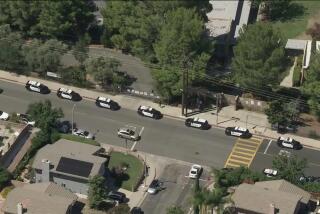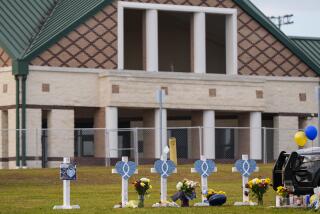Plotters of school killings tend to tip off someone in advance
- Share via
It was the Connecticut school massacre that never happened.
A 16-year-old junior was stockpiling guns in his bedroom closet for an attack on April 10, 2007. In a red folder on his nightstand, he kept a map of his high school in the town of Newington, a hit list of more than 20 classmates, a timeline of a killing plan that ended with his own suicide, and photos of Dylan Klebold and Eric Harris of Columbine infamy.
But Frank Fechteler never had the chance to carry out his plot; a girl had caught word of the planned attack and told her parents and the police.
Rampages such as the one this month at Sandy Hook Elementary School in Newtown, Conn., invariably raise the question of how the shooters might have been identified in time to prevent their deadly assaults.
There is no psychological profile specific enough to pinpoint school shooters in advance. But one common thread may offer the best opportunity to intercept them: They tend to be indiscreet during their planning stages. The difference between a tragedy and a tragedy averted, experts say, is often somebody who knows something deciding to speak up.
Ironically, the security measures instituted by many schools after the 1999 Columbine High School massacre in Colorado may discourage students from sharing potentially life-saving information. Metal detectors, cameras, increased police presence and indiscriminate disciplinary policies, at their worst, can create a culture of mistrust and silence, researchers said.
“Kids are less likely to come forward if they perceive an authoritarian stance,” said Eric Madfis, an assistant professor of criminal justice at the University of Washington branch in Tacoma.
It is unclear whether Adam Lanza, the 20-year-old loner who killed 20 first-graders and seven adults before turning a gun on himself, had revealed his plans to anybody. There is little research on whether adult mass murderers are prone to what criminologists refer to as “leakage.”
But a 2004 report by the U.S. Secret Service and the Department of Education found that teenage shooters tend to talk.
The study examined 37 attacks on schools dating to 1974. In 81% of those cases, at least one other person — typically a friend, classmate or sibling — had some prior knowledge of the event. In 59% of the cases, more than one person knew.
In a follow-up report, bystanders who had remained silent told researchers that they worried about adults overreacting if the information turned out to be wrong.
Killing schemes have been revealed after the plotters unsuccessfully tried to recruit other students, bragged about their plans or warned friends to stay home on a particular day.
Fechteler’s 2007 plot against Newington High School in Connecticut was broken up two months before he was to carry it out.
The unidentified girl who spoke up testified in a sworn affidavit that a boy she knew and his friend “Frank” had been talking about an attack on the school since December 2006. After the boy sent her links to YouTube videos of Fechteler shooting rifles and setting off explosives, she felt threatened enough to tell her parents.
Fechteler, who had no history as a troublemaker, pleaded guilty to making threats and a bomb and was sentenced to three years in prison.
Psychologists can characterize rampage shooters only in broad terms.
The typical perpetrator is a white male who lives in a tightknit suburb or rural area, where life can be especially difficult for people who don’t fit in. He has been bullied. He suffers from depression or another psychiatric disorder and is deeply frustrated with his life, blaming others for his miseries. He begins planning his crimes after a loss that feels catastrophic — a job or a girlfriend, for instance.
And he has easy access to semiautomatic firearms.
While that description is accurate, it’s not very useful.
“There are hundreds of thousands of students who fit the profile of the school shooter and wouldn’t hurt anybody,” said Jack Levin, a Northeastern University sociologist and criminologist who studies mass murder.
One reason the description is so broad is that school shootings are rare. More Americans are struck by lightning each year than killed in rampage shootings.
The number of mass murders — defined by the FBI as having at least four victims — has been stable over the last three decades at about 20 attacks and 100 to 150 victims a year, Levin said. The widespread perception of a rise comes from the media attention the killings receive, he said.
Thwarted school plots, though barely studied, are more common.
Madfis identified 195 foiled plots between 2000 and 2009. He said he found no instances in which cameras or metal detectors made a difference. When plots were broken up, it was most frequently because students told authorities, he concluded in a detailed study of 11 incidents.
But in several prominent attacks, a “code of silence” among students allowed attackers to follow through on their plans.
In 2001, a 16-year-old used his father’s .22-caliber revolver to kill two classmates and injure 13 others at Santana High School in Santee, Calif. As many as 20 students knew about his plan, investigators found. One broke down in tears in a radio interview, saying he felt responsible for the shooting because he had failed to alert authorities.
In Pearl, Miss., in 1997, a 16-year-old stabbed his mother to death at home, drove to his high school and shot and killed two students and injured seven others. He had told some friends to stay home that day, but none of them warned the school.
“There is a teen culture of anti-snitching,” said Jeff Daniels, an expert on school violence at West Virginia University.
He and other researchers said that culture was reinforced by “zero tolerance” disciplinary policies, which have led to students being expelled for making idle threats or bringing a water pistol to school. The sense of disproportionate punishment discourages students from sharing information.
Whether students perceive the school climate as fair, democratic and cohesive is by far the most important factor in whether they share information, several studies have concluded.
Simple measures can be surprisingly effective in building trust between students and adults.
One district in California began requiring each teacher, administrator, janitor and cafeteria worker to strike up a conversation with a student between each class period, said Marisa Randazzo, a threat assessment expert who has studied school shootings for the U.S. Secret Service. The school staff learned about pregnancies, drug use and domestic violence — and opened channels of communication that could head off violence.
More to Read
Sign up for Essential California
The most important California stories and recommendations in your inbox every morning.
You may occasionally receive promotional content from the Los Angeles Times.














